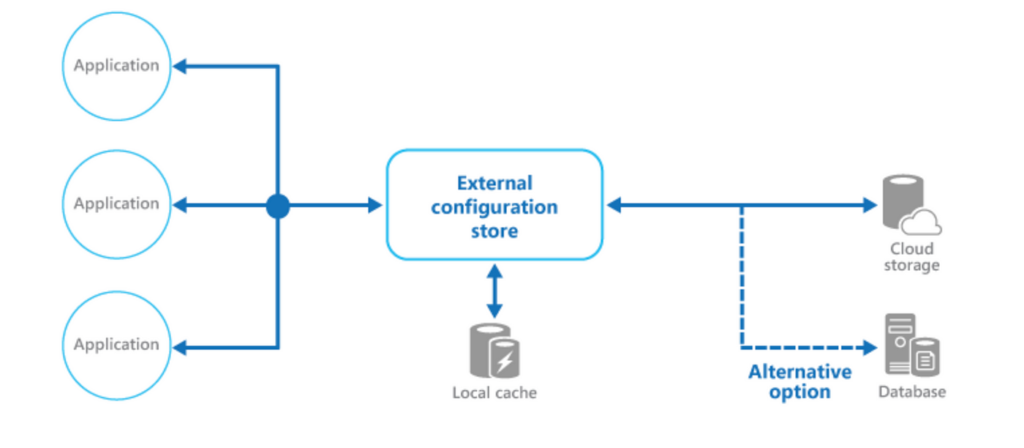How Configuration Externalization Work
In this tutorial, we are going to discuss about the How Configuration Externalization Work and its architectures. Configuration externalization works by separating configuration data from the application code, typically through external files, environment variables, or configuration management systems.
You’ve heard about the value that the Configuration Externalization Pattern brings to the table, but now let’s roll up our sleeves and dive into the intricate workings of this pattern. We’ll start by examining the architecture of the pattern, unveiling its structure, and exploring the mechanisms that make it tick.

Lets explore How Configuration Externalization Work and its architectures.
A Walkthrough of the Configuration Externalization Architecture
At the heart of the Configuration Externalization Pattern, you’ll find two main components – the microservice itself and the configuration server (or configuration file). These two actors interact harmoniously to manage configurations in a microservices architecture effectively.
The microservice, at its start-up or at pre-defined intervals, sends a request to the configuration server or file, asking for its configurations. These configurations can include information like database connection settings, API keys, or any other environment-specific data. Once the request is received, the configuration server sends back the configurations that the microservice needs.
What’s fascinating about this exchange is that it happens dynamically, at runtime. The microservice can adapt in real-time to new configurations, without needing a restart or redeployment. This dynamic interchange of configurations not only reduces the downtime but also enhances the agility of your system.
The Configuration Server: Centralization for the Win
The configuration server is the nerve center of the Configuration Externalization Pattern. Think of it as the command center that oversees and controls all configurations. This server stores, retrieves, and manages configurations for all microservices.
To further streamline the process, configurations can be organized by environment (development, staging, production), by microservice, or even by instance of a microservice. It’s like a well-organized library, with each configuration neatly categorized and easy to find. This efficient organization mitigates many challenges associated with traditional configuration management.
Dynamic Adaptability: Embracing Change on the Fly
Here’s where things get interesting. As we mentioned earlier, the Configuration Externalization Pattern thrives in dynamic environments. It’s designed to adapt configurations on-the-fly, in response to changing conditions. But how does this work in practice?
Let’s say you have a microservice that interacts with a database. The database connection parameters are stored as configurations in the configuration server. Suddenly, there’s a change in the database connection parameters. Instead of needing to redeploy the microservice with the new parameters, the configuration server is updated with the new connection parameters. The microservice, when it next retrieves configurations, receives the updated parameters and continues its operation seamlessly. It’s that simple and efficient!
Security: Safeguarding Sensitive Configurations
Remember the library analogy we used to describe the configuration server? Well, just like a library, not all books (or in our case, configurations) are open for everyone to read. Some configurations might contain sensitive data that need to be protected. And the Configuration Externalization Pattern handles this brilliantly.
The configuration server can secure sensitive configurations through various means, such as encryption or access controls. By centralizing the management of these sensitive configurations, it’s easier to enforce strict security policies, reducing the risk of inadvertent exposure or malicious attacks.
Scalability: Growing with Grace
We all know that a microservices architecture thrives on scalability, and guess what? The Configuration Externalization Pattern scales with you. As you add more microservices to your architecture, you can simply add their configurations to the configuration server. You don’t need to worry about individually managing configurations for each new service. This centralization makes scaling up a breeze!
Consistency: Maintaining Harmony Across Environments
In the world of software development, moving from development to testing, and then to production can sometimes feel like entering different countries, each with its own rules and languages. But not when you’re using the Configuration Externalization Pattern!
By externalizing configurations, you can maintain consistency across these environments. You just need to switch the configurations as you move through the environments. No more worrying about environment-specific code or configurations getting mixed up!
That’s all about How Configuration Externalization Work. If you have any queries or feedback, please write us email at contact@waytoeasylearn.com. Enjoy learning, Enjoy Microservices..!!